How to make money blogging
Making money blogging is definitely possible, but it takes time, effort, and dedication

It’s no secret that blogging has become one of the most popular ways to make money online. In fact, there are now over 31 million bloggers in the United States alone.
If you’re thinking about starting a blog, you may be wondering how you can get in on this trend and start earning an income from your blog.
Fortunately, it’s not as difficult as you may think. With a little guidance, anyone can learn how to make money blogging. In this blog post, we’ll share some of the most effective strategies for monetizing your blog and help you get started on your journey to financial success using the best blogging sites on the market.
How do bloggers really make money?
When it comes to monetizing a blog, there are a few different ways that bloggers can go about it. Generally, bloggers make money in two different ways:
Partnering with businesses - For instance, the blogger may use their site as ad space for brands to promote their products or services. Alternatively, they may write a sponsored post that features the company’s items or campaigns.
Selling a product or service to readers - Examples include eBooks, merchandise, coaching services, or membership content. For this method to succeed, the bloggers’ focus should be on offering value that the audience can’t find anywhere else.
How much money a blogger makes usually depends on their income-making methods and the amount of traffic their website receives. Typically, having more diverse monetization outlets and higher visitor volume will result in higher income.
Are you a pro? Subscribe to our newsletter
Sign up to the TechRadar Pro newsletter to get all the top news, opinion, features and guidance your business needs to succeed!

For example, Adam Enfroy’s blog brings in around 332,854 pageviews in a month. With such traffic, he can generate $101,814 simply from people viewing the ads on his blog, clicking an affiliate link, or purchasing his digital products.
As such, it’s best to focus on building a loyal following before you can start making money online. Businesses often look for content creators with steady traffic to gain the most exposure and conversions out of the partnership.
Furthermore, if you’re selling your own products or services, it’s much easier to make a sale when the blog already has an existing audience.
How to start your own blog
If you’re a beginner blogger, it’s essential to know how to start a successful blog before learning how to make money with it. This tutorial will walk you through the steps for launching a website, creating content for the blog, and optimizing it for search engines.

1. Pick a hosting provider
The first step when starting a blog is purchasing web hosting. It’s a service that stores the website files and makes them accessible to the public.
There are many web hosts on the market to choose from. Hence, you should pick a reliable provider that will have the blog up and running at all times so that readers can enjoy your content 24/7. Additionally, make sure to choose a service with a beginner-friendly control panel and a responsive support team.
If you’re looking for recommendations, check out our list of the best web hosting services. Here are some of our top picks:
- Hostinger - This hosting company offers shared hosting plans perfect for new bloggers. The features include a 99.9% uptime guarantee, 24/7 live chat support, and an intuitive built-in control panel.
- Bluehost -. A feature-rich hosting provider with speedy performance. The plans include custom website themes, free domain name registration for a year, and a free SSL certificate to secure the site connection.
- HostGator - This web host provides unmetered bandwidth and unlimited storage in all plans, which are necessary to support the blog’s growth. The shared hosting plans come with a 45-day money-back guarantee included.
After purchasing a web hosting account, you’ll need to buy a domain name – it’s the web address that readers will enter on their browser to open your site.
The name should describe the blog in a few words and be catchy enough to easily remember. Also, consider securing a .com TLD since it's the most familiar extension to users. The average price for it is $8/year.
2. Pick a website platform
After purchasing a hosting service and a domain name, we’ll need to choose a platform to create the blog with.
The most popular option is self-hosted WordPress. It’s a content management system (CMS) to build and publish websites with little to no technical knowledge.
It also features powerful blogging capabilities, such as a post editor, a category and tagging system, and commenting features.
Another benefit to using WordPress is its vast theme collection. The official directory alone has over 8 thousand free selections available, so there are plenty of styles to play around with.
If you’re looking for a fast and highly-customizable pick, check out our list of best WordPress themes.
WordPress is highly customizable mainly due to its plugins, which are extensions you can install to enhance the blog’s features.
For instance, the Gravity Forms plugin can add a contact form to the blog, allowing readers to reach out directly to your email. We also recommend that you checkout our roundup of the best WordPress plugins to improve site content, functionality, and performance.
Besides WordPress, other well-known CMSs include Drupal and Joomla. While they are perfectly capable of blogging, they may have a steeper learning curve.
- These are the best blogging platforms around
3. Create quality content
Now it’s time for the fun part - creating content for your blog. Depending on the focus of your blog, this could mean anything from writing articles and taking photos to recording videos and podcasts. Whatever form your content takes, make sure it is high quality and engaging so that people will want to keep coming back for more. Once you have some content created, it’s time to start promoting your blog so that people actually see it.
With the website set up, it’s time to create content for the blog. This is a crucial step, as visitors decide whether your blog is worth checking out further from the quality of its articles.
Here are some best practices for creating valuable content for readers:
Choose a profitable niche - Pick a range of topics that can potentially attract a sizable audience and business partners. Ideally, the subject should also be within your interests to prevent burning out as an author.
Find a content gap - If the niche is popular, choose a specific angle that the major competitors haven’t tapped into yet. That way, the blog can become the go-to source for such topics.
Focus on your target audience - Figure out what content they’re interested in and what problems they need solving. A great post should be able to offer the answers they’re looking for. Use keyword research tools to find blog post ideas.
Choose evergreen topics - These are subjects that never go out of trend and people often ask about, such as “how to save money.” A new blog should focus on such content as it will always remain relevant to readers’ interests, helping build traffic over time.
Use an editorial content calendar - Create a timeline for researching, writing, editing, and publishing the blog posts to ensure productivity.
Prioritize readability - Besides tackling readers’ pain points, a great article is also easy to read and understand. Use short paragraphs, unordered and ordered lists, and simple language.
Incorporate imagery - Use pictures and videos to help visual learners process the information from the blog post.
When in doubt, look for free articles online - It’s an excellent way to populate your blog content fast. However, some posts don’t have the best quality, so it’s best to edit them before publishing.

4. Optimize your site for search engines
If you want people to find your blog online, it's important that your site is optimized for search engines like Google and Bing. That means including relevant keywords throughout your website so that people can easily find it when they're searching for topics related to what you're writing about.
It also means making sure that your website is easy for search engines to crawl—in other words, that it's well-organized and free of errors like broken links . A good way to check this is by using Google's Mobile-Friendly Test tool which will scan your website and let you know if there are any areas where it needs improvement.
5. Start using money-making techniques
Now that we’ve covered the basics of how to create a blog, let’s discuss several ways you can utilize it to earn money online.
First, remember that you may not make as much money as expected at the beginning of your blogging journey. As such, make sure to set realistic expectations.
Additionally, consider experimenting with different monetization methods to increase your income potential and see which one works best for your blog.
There are a few different ways to make money from your blog, but one of the most popular is through affiliate marketing. Sponsored posts are basically when companies pay you to write about their products or services on your blog. This is usually done in exchange for a free product or service, but sometimes companies will pay cash as well.
Best and proven ways to make money blogging
This section will cover how to make money blogging in 12 different ways. We’ll explain what each method entails and some tips to set you up for success.

1. Google AdSense
Google AdSense is one of the most popular platforms to make money online. This ad network will connect you with businesses that want to advertise on your website. Depending on the advertiser, the blogger will get paid every time someone views or clicks the ad.
One advantage of joining Google AdSense is they will handle most of the work for you, from finding advertisers to optimizing the ads for the website.
Furthermore, the system will select the most profitable and highest-quality ads to get the best results. It’s also possible to block irrelevant ads and customize the ad placement.
Unlike other ad networks, AdSense doesn’t have a minimum traffic requirement. However, it’s recommended to have at least a hundred unique visitors a day to start making money. Note that the platform only allows withdrawing payments once your account gains $100.
The signup process is easy. Simply create a Google AdSense account, insert a piece of code to your website, and enter your phone number and payment information.
Then wait for a few days or up to two weeks for the team to review the site’s eligibility. Be sure to comply with the program policies to increase your chances of approval.
If your site gets rejected, check out other alternatives like InfoLinks or PropellerAds. They don’t impose any minimum traffic requirement and have a much lower payout threshold than AdSense.
2. Selling ad space to businesses
Joining an ad network is a great way for beginners to make money blogging. However, once the blog has grown bigger to 100,000 pageviews, consider selling ads directly to businesses.
Cutting the middleman will allow for more control over which brands can advertise on the website, what type of ads to display, and how much income you make.
That said, there is more work involved if you want to sell ad space without joining a network.
For instance, it’s important to know how to configure the ad yourself so that they look good on users’ screens. Bloggers typically offer space for banner ads, which show up on the top, bottom, or sides next to the main content area to avoid intruding on the reading experience.
Moreover, you have to decide how much to charge per ad.
Entrepreneur Yaro Starak recommends dividing your daily unique visitor count by ten to get a base price. In other words, if there are 3000 people coming to your website each day, consider charging $300 for each ad.
After figuring out the types of ads to sell and their prices, send email pitches to brands in your niche. Express how lucrative your blog can be for their business by showing stats of the traffic, demographics, and social media presence.
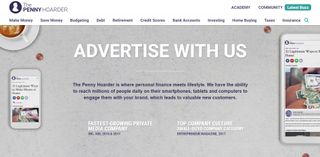
Also, consider creating an Advertise with Us page, just like in this example by The Penny Hoarder.
3. Affiliate marketing
Affiliate marketing is a highly-lucrative monetization method. Ryan Robinson, one of the most successful bloggers on the market, has collected over $17,000/month in affiliate income, making up half of his earnings.
Using this method, you will work with a brand to feature their products or services on the blog. The business will provide you with an affiliate link that will redirect readers to their online store, where they can purchase the item.
Depending on the company, the blogger will receive a commission every time someone clicks on the link or places an order through it.
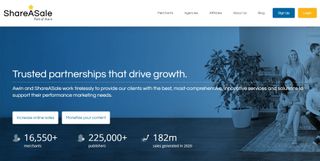
There are two ways to get started with this monetization strategy. One is to join an affiliate network, like Amazon Associates or ShareASale. These platforms will connect you with merchants interested in having their products or services featured.
Another method is by checking out company websites. Some may specify they have an affiliate program available for content creators.
If you need some references, check out the following affiliate programs:
Skillshare -This online learning platform offers $7 in commission for every new signup. Any blogger can join for free if they have a Skillshare and an Impact Radius account.
TripAdvisor - Earn at least 50% in payment every time someone visits TripAdvisor’s hotel booking partner website. The user doesn’t need to make a reservation for the affiliate to get paid.
NordVPN - This VPN software has generous payout plans. If a first-time buyer signs up for a one-month subscription, the affiliate will receive 100% commission.
Bluehost - This hosting company spends $5 million in affiliate payments alone in one year. The blogger will receive $65 for every visitor that checks out the link and purchases a plan.
Hostinger - Another hosting provider with a high-paying commission. Affiliates can earn at least 60% of every sale.
When finding affiliate programs, make sure the brand is relevant to the audience’s interests. Otherwise, it will be challenging to get them to click on the link or make a purchase.
Additionally, incorporate the affiliate products naturally into your content – appearing too “salesy” can risk annoying readers.
Some popular blog post examples for affiliate marketing include reviews or buying guide listicles. It’s also possible to feature a product or service in a how-to tutorial if one of the steps requires it.
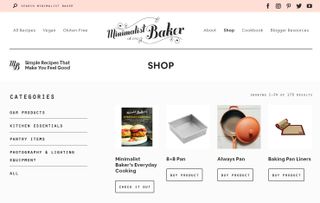
Alternatively, consider creating a dedicated shop page for your most recommended products, like what the food blog Minimalist Baker does on their website.
4. Sponsored posts
Writing sponsored posts is another great way to partner with businesses. Like joining an affiliate network, you will make money by promoting a brand with your content.
What makes it different is that the sponsor will usually provide a guideline on presenting the product or service. The blogger’s job is to follow this brief while also creating content that naturally resonates with readers.
High-traffic bloggers usually have better chances at securing sponsorships since they have a wider reach. However, many brands are also looking to work with smaller content creators due to their higher engagement rate.
The income depends on the project, though most bloggers charge an average flat rate of $100. In addition to traffic size, your website’s domain authority can also affect the pricing.
There are three ways to land a sponsored post opportunity:
Join a content creator network - This kind of platform helps bloggers and social media influencers find relevant brands to partner with. Check out IZEA or AspireIQ.
Approach brands directly - Send an email explaining why your blog is the perfect space for them to market their offer. Include some traffic and engagement stats for supporting evidence as well as several content ideas.
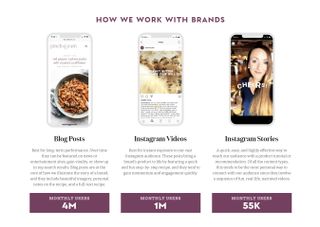
Create a Sponsor page to attract brands - Pinch of Yum has an excellent example of this. Besides featuring their monthly visitor and social media follower stats, it also has case studies of previous partnerships to demonstrate their successes.
4. Online courses
Done properly, launching an online course can generate substantial income. Many bloggers and content creators today charge hundreds to thousands of dollars for a single series.
A successful online course starts with choosing the right topic. Besides showcasing your expertise and passions, the subject should also pertain to the audience’s needs and problems. Otherwise, compelling them to purchase the program can be difficult.
Consider the following questions when coming up with a course idea:
What topics or issues do readers frequently come to you for?
Are there similar online courses on the market? Is there a content gap you can fulfill?
What learning milestones and outcomes will the participants achieve?
Other necessities include video equipment, editing software, and an online course platform to host the learning materials.
Many bloggers use Teachable, which comes with a course builder, multiple pricing systems, and international payment methods. WordPress users can also install an LMS plugin like LearnPress.
When it comes to pricing, the recommended baseline is around $100. It’s possible to charge higher by creating a tier system with bonus content and privileges for every level. Additionally, set up payment plans to make the online course more widely accessible.

To market the online course, most bloggers create a long-form landing page that explains what the program includes and shows customer testimonials for social proof. Some like Elna Cain also offer a free mini email course so that prospective participants can see what they can gain.
- We've also rounded up the best online courses
6. Coaching or consulting services
Coaching or consulting are a few of the freelance services bloggers can offer to their audience.
With coaching, you will offer one-on-one or group mentoring sessions to help customers achieve a certain goal. The topic can range from entrepreneurship, health, wellness, career development, to communication skills.
Like online courses, you will need a program that demonstrates your expertise and panders to existing demand.

A good example of an online coach is Gemma Gilbert, who helps moms attract more clients for their businesses. Addressing a specific target market in her unique selling point makes it easier for her service to stand out among similar programs.
On the other hand, consulting focuses on offering expert advice to solve a client’s problem.
For instance, if you have an interior design blog, the consulting services can include creating a blueprint according to the client’s goals, assessing their budget, or suggesting some decor items.

A well-known blogger that offers a consulting service is Neil Patel. His content marketing experts can perform a website audit for the client and create an execution plan to help grow their online presence.
New coaches and consultants typically price their services by the hour, though experts recommend charging a monthly flat rate or creating package-based fees once the business has grown.
With that in mind, consider getting coaching or consulting certification. Besides boosting credibility, it can also help increase rates.
7. eBooks
eBooks are one of the most popular go-to digital products to make money blogging with. Not only do they require minimal production costs, but they’re also a great way to repurpose related blog posts into one long-form content.
Harsh Argawal does with his affiliate marketing handbook, combining multiple articles on the same subject into one comprehensive guide. That way, readers can simply purchase the eBook instead of navigating through different pages to read all the information.
Also, it’s good to offer more value to the product by including some extras. For instance, this handbook contains instructional videos on getting started with well-known affiliate marketplaces. It even gets regularly updated to ensure the content stays fresh and relevant.

If you want to launch a writing career, creating eBooks is an excellent way to do that. The digital book market grows every year, and many writers like Mark Dawson have found success with self-publishing.
Platforms like Amazon KDP and Barnes & Noble Press can help sell eBooks to a vast market. However, you’ll compete with thousands of other writers on the site, so some extra effort into marketing may be necessary. Plus, remember to take into consideration the royalty percentage.
Many bloggers also sell eBooks right from their websites. WordPress users can do this with an eCommerce plugin like WooCommerce or Easy Digital Downloads.
- Want to start writing? These are the best laptops for writers
8. Digital products
Besides online courses and eBooks, here are other digital product ideas:
Printables - These are PDFs people can download and print for personal use. For instance, many travel bloggers sell a budget planner or packing checklist to help readers with their trips. Blogger Sarah Titus makes $5 million/year with this digital product.
Premium newsletters - This digital product can be profitable if you can offer exclusive content that people are willing to pay regularly for. A good example is Jessie on a Journey’s VIP Opportunities List, a newsletter for travel bloggers looking to find paid gigs.
Digital prints - This idea is excellent for photography, home decor, travel, art, or design blogs. Lifestyle bloggers A Beautiful Mess sell downloadable photographs and artwork that readers can print and display around their homes.
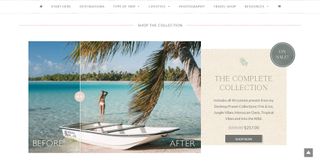
Image-editing presets - Another great option for those who take a lot of original photos for their blog and social media. Sell several packs with different themes and effects, like travel blogger The Blonde Abroad.
Graphic design assets - These can be stock photos or templates for featured images, social media posts, and newsletters. Take a look at the marketing blog Ivory Mix for an example.
Swipe files - If you have a knack for copywriting, consider selling templates that other content creators can use for their own marketing. Entrepreneur Kimberly Ann Jimenez does this to help fellow freelancers with their email campaigns.
WordPress themes or plugins - This product idea is best for those with some coding skills. Fellow bloggers will always be looking for new templates or extensions to enhance their website with.
9. Physical products
There are plenty of bloggers making money with physical products. Many like Liz Marie create merchandise for their followers, such as t-shirts, tote bags, or mugs.

Some also develop items that readers can incorporate into their lifestyles, such as Tiny Buddha, which sells a personal care kit and journals for mindfulness.
These days, starting an online store has become easier with the best ecommerce platforms. After finding a product that resonates with readers, simply create an account, configure the shop website, and hit publish.
If you want to sell physical items with low startup costs, consider dropshipping.
This business model requires working with a wholesaler to have their products displayed on your online store. The supplier will take care of all the fulfillment and shipping, while you handle the marketing and customer service.
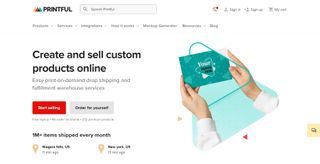
Find dropshipping suppliers by joining platforms like Oberlo. Alternatively, check out on-demand printing services like Printful if you want to create merch.
Another way to sell your own products is by collaborating with brands. Fashion blogger Samantha Maria does this with the company Stilnest to create a custom jewelry collection.
10. Online events
This monetization method involves developing and hosting an online event, such as a live webinar, conference, or summit. It’s a clever way to make money while also generating leads and developing your personal brand.
Regardless of the event type, be sure to come up with a program that people will happily pay for. Meaning, the content should include valuable information that the audience won’t normally get with a quick search.
If you’re conducting live interviews, invite well-known speakers in your niche to reach a wide audience and boost credibility.
Finally, consider investing in high-quality recording equipment to ensure a smooth viewing experience.
There are several ways to monetize an online event. Some make the content available for free on the day of launch, then charge a lifetime access pass for those who want to rewatch it in the future. Doing this ensures that the event reaches as many potential customers as possible.

It’s also possible to cross-sell some digital products at the end of the event. This is a pro tip recommended by Navid Moazzez, a virtual summit expert who made $60,000 in his first event.
11. Paid memberships
This money-making tactic is also an excellent way to foster an online community.
Here, you will set up a membership system where paying users can get premium benefits. Examples include behind-the-scenes content, live group discussions, or exclusive expert resources.
There are two popular ways to create a membership system. One is to use Patreon, which is a popular platform among content creators.
It comes with all the features necessary to connect with subscribers and set up subscription plans. However, it will deduct a small percentage of your monthly income.
For WordPress users, another option is to use a membership plugin. This method allows for more freedom to customize the system and pricing, making it easier to personalize the membership experience to your audience.

A good example of a paid membership site is Pinch of Yum’s Food Blogger Pro. It aims to help subscribers who want to make money from their food blog by offering expert training and community forums.
12. Donations
The last monetization strategy we recommend is accepting donations. If you have a dedicated and loyal audience, chances are they are willing to pay money for you to create content.
The personal blog Captain Awkward resorts to this method to avoid displaying ads, which isn’t suitable for her content and can make for a poor user experience.
Enable donations by adding a PayPal Donate button to the blog. The transaction fee is 2.9% and $0.30 per payment. A similar feature is also available on Amazon Pay and Apple Pay.
Making money from blogging
This guide has shown you everything needed to know about making money blogging.
First, we covered how to start a profitable and successful blog. Before implementing any monetization method, make sure to focus on delivering valuable and SEO-friendly content to build your audience.
We’ve also discussed how to make money blogging in 12 different methods. Some are better-suited for certain blogs than others, but these top five are best for beginners:
Google AdSense - This platform will display ads on your website and pay you every time someone views or clicks on it.
Affiliate marketing - Feature third-party products on your blog posts and get paid each time a reader visits the link to the online store or makes a purchase.
Online courses - Create a series of videos teaching users how to develop a particular skill.
eBooks - Repurpose existing blog posts into one long-form content. Sell them on your website or with self-publishing platforms like Amazon KDP.
Digital products - Create a downloadable item that readers can utilize, such as printables, image-editing presets, or graphic design templates.
Once your audience has grown, consider trying the rest of the methods to increase your income potential. Good luck.
- Also check out our complete list of the best web hosting services
Ruby has been a freelance technology writer for over four years and has a passion for information technology and the Internet in its entirety. She has a wide range of specialities including web hosting, streaming (Firestick, Kodi, and APKs), VPN, information technology, and affiliate marketing. Ruby is a graduate of Bachelor of Science in Commerce from the University of the Philippines, and regularly codes in her free time.
